Primary Health Practice: Analysing Project Piaxtla from a Participatory Planning Approach
VerifiedAdded on 2023/06/11
|13
|3619
|116
AI Summary
This study analyses the Project Piaxtla from a participatory planning approach and its impact on rural inclusion and empowerment through primary healthcare practices. It discusses the barriers faced in the implementation of the project and provides a critical analysis of the same. The subject is primary healthcare and the course code is not mentioned. The course name and university are also not mentioned.
Contribute Materials
Your contribution can guide someone’s learning journey. Share your
documents today.
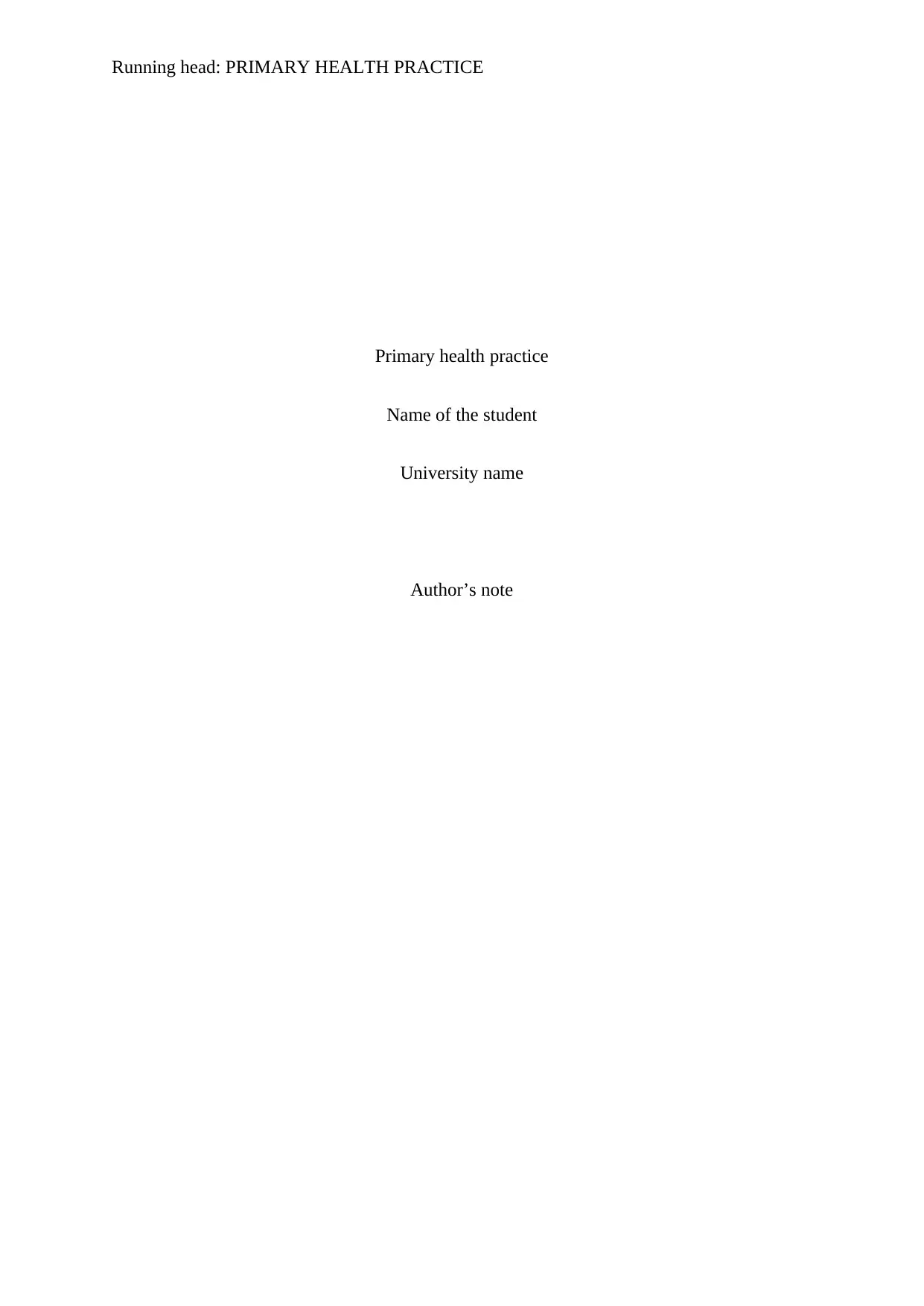
Running head: PRIMARY HEALTH PRACTICE
Primary health practice
Name of the student
University name
Author’s note
Primary health practice
Name of the student
University name
Author’s note
Secure Best Marks with AI Grader
Need help grading? Try our AI Grader for instant feedback on your assignments.
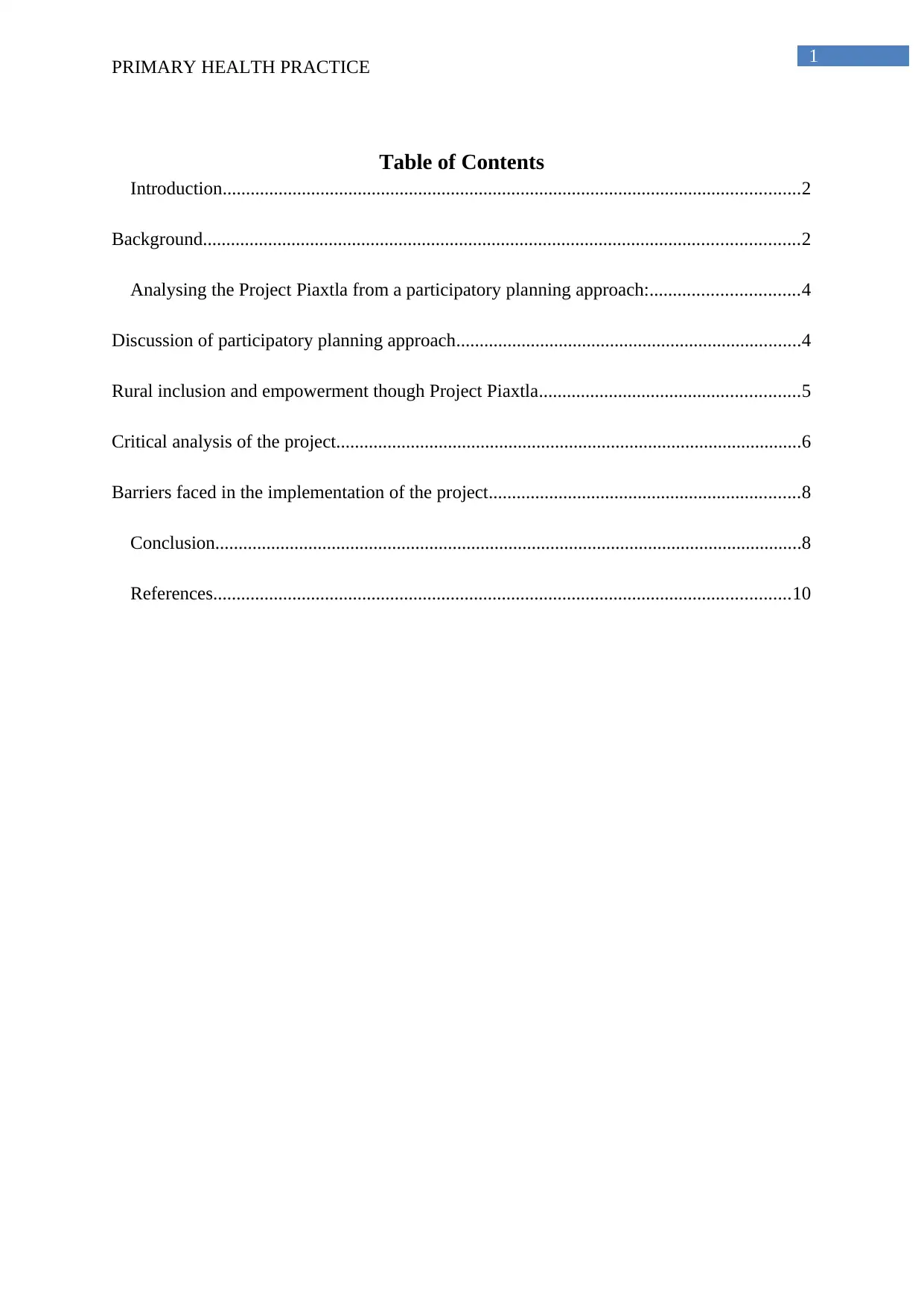
1
PRIMARY HEALTH PRACTICE
Table of Contents
Introduction............................................................................................................................2
Background................................................................................................................................2
Analysing the Project Piaxtla from a participatory planning approach:................................4
Discussion of participatory planning approach..........................................................................4
Rural inclusion and empowerment though Project Piaxtla........................................................5
Critical analysis of the project....................................................................................................6
Barriers faced in the implementation of the project...................................................................8
Conclusion..............................................................................................................................8
References............................................................................................................................10
PRIMARY HEALTH PRACTICE
Table of Contents
Introduction............................................................................................................................2
Background................................................................................................................................2
Analysing the Project Piaxtla from a participatory planning approach:................................4
Discussion of participatory planning approach..........................................................................4
Rural inclusion and empowerment though Project Piaxtla........................................................5
Critical analysis of the project....................................................................................................6
Barriers faced in the implementation of the project...................................................................8
Conclusion..............................................................................................................................8
References............................................................................................................................10
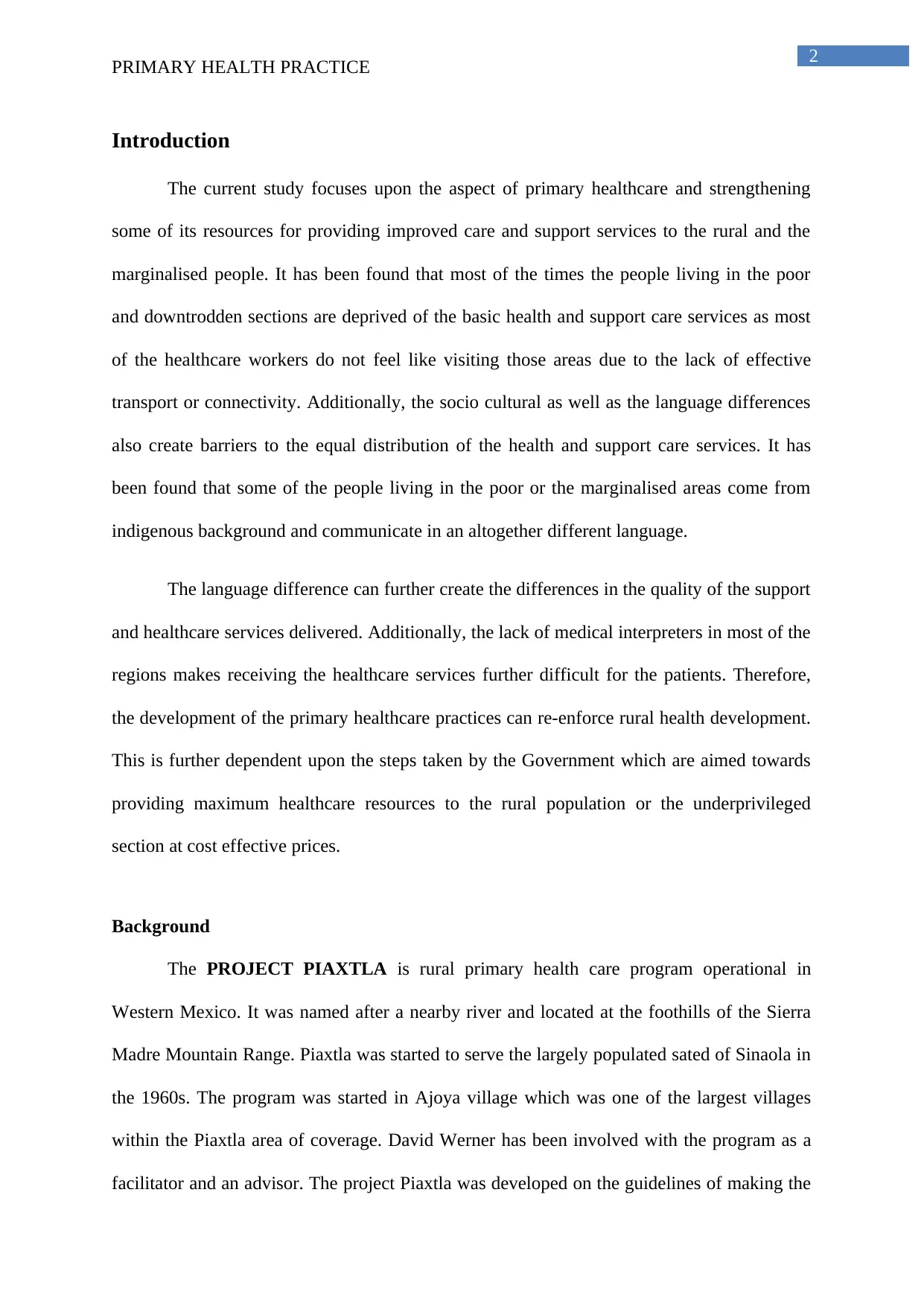
2
PRIMARY HEALTH PRACTICE
Introduction
The current study focuses upon the aspect of primary healthcare and strengthening
some of its resources for providing improved care and support services to the rural and the
marginalised people. It has been found that most of the times the people living in the poor
and downtrodden sections are deprived of the basic health and support care services as most
of the healthcare workers do not feel like visiting those areas due to the lack of effective
transport or connectivity. Additionally, the socio cultural as well as the language differences
also create barriers to the equal distribution of the health and support care services. It has
been found that some of the people living in the poor or the marginalised areas come from
indigenous background and communicate in an altogether different language.
The language difference can further create the differences in the quality of the support
and healthcare services delivered. Additionally, the lack of medical interpreters in most of the
regions makes receiving the healthcare services further difficult for the patients. Therefore,
the development of the primary healthcare practices can re-enforce rural health development.
This is further dependent upon the steps taken by the Government which are aimed towards
providing maximum healthcare resources to the rural population or the underprivileged
section at cost effective prices.
Background
The PROJECT PIAXTLA is rural primary health care program operational in
Western Mexico. It was named after a nearby river and located at the foothills of the Sierra
Madre Mountain Range. Piaxtla was started to serve the largely populated sated of Sinaola in
the 1960s. The program was started in Ajoya village which was one of the largest villages
within the Piaxtla area of coverage. David Werner has been involved with the program as a
facilitator and an advisor. The project Piaxtla was developed on the guidelines of making the
PRIMARY HEALTH PRACTICE
Introduction
The current study focuses upon the aspect of primary healthcare and strengthening
some of its resources for providing improved care and support services to the rural and the
marginalised people. It has been found that most of the times the people living in the poor
and downtrodden sections are deprived of the basic health and support care services as most
of the healthcare workers do not feel like visiting those areas due to the lack of effective
transport or connectivity. Additionally, the socio cultural as well as the language differences
also create barriers to the equal distribution of the health and support care services. It has
been found that some of the people living in the poor or the marginalised areas come from
indigenous background and communicate in an altogether different language.
The language difference can further create the differences in the quality of the support
and healthcare services delivered. Additionally, the lack of medical interpreters in most of the
regions makes receiving the healthcare services further difficult for the patients. Therefore,
the development of the primary healthcare practices can re-enforce rural health development.
This is further dependent upon the steps taken by the Government which are aimed towards
providing maximum healthcare resources to the rural population or the underprivileged
section at cost effective prices.
Background
The PROJECT PIAXTLA is rural primary health care program operational in
Western Mexico. It was named after a nearby river and located at the foothills of the Sierra
Madre Mountain Range. Piaxtla was started to serve the largely populated sated of Sinaola in
the 1960s. The program was started in Ajoya village which was one of the largest villages
within the Piaxtla area of coverage. David Werner has been involved with the program as a
facilitator and an advisor. The project Piaxtla was developed on the guidelines of making the

3
PRIMARY HEALTH PRACTICE
residents of the village self sufficient by providing them as well as educating them about
health care methods and approaches. However, the economic crisis in the 1990s as an
aftermath of the North American Free Trade Agreement (NAFTA) created a huge bridge
between the rich and the poor. It further resulted in discrepancies within the health and
support care services. The economic crisis accompanied by civil disharmony within the
Ajoya village where thefts, assaults and murders were common on a day – to – day basis
made survival difficult over there. As mentioned by Hall et al. (2017), the civil disharmony
made many people fled from the village of Ajoya and the surrounding regions due which the
project Piaxtla almost came to a dead end. As argued by Hopwood (2015), there has been
recent rise in activities such as drugging and trafficking of drug, which made the region
unsafe for people to exist, as a result many people left the region.
There has been a gradual evolution in the strategies of Piaxtla from curative care to
social action. Here, the improvement in health was brought about in three phases. In the
earliest stage, it had no political agenda and only focussed upon providing immediate cure to
the people. The village health advocates were trained using participatory learning approaches.
By the end of these programs they grew sufficiently competent in dealing with the common
illness and injuries (Hall et al. 2017). However, a gradual recurrence pattern was seen in the
illnesses. Therefore, the goal was to shift from curative mode of care to preventive mode of
care. Here, the main focus was given on improving the water and sanitation systems, as it
was found that most of the villagers did not use proper sanitation techniques as well as they
did not have proper access to safe and clean drinking water. Due to the success of the
program the under five mortality rate in children due to common illnesses such as measles,
whooping cough, polio was reduced by drastic rates. However , the problem persisted in a
certain section of the poor children without proper home and family and were often taken
advantage of by the wealthy section of the society. Therefore, the goal of the program was
PRIMARY HEALTH PRACTICE
residents of the village self sufficient by providing them as well as educating them about
health care methods and approaches. However, the economic crisis in the 1990s as an
aftermath of the North American Free Trade Agreement (NAFTA) created a huge bridge
between the rich and the poor. It further resulted in discrepancies within the health and
support care services. The economic crisis accompanied by civil disharmony within the
Ajoya village where thefts, assaults and murders were common on a day – to – day basis
made survival difficult over there. As mentioned by Hall et al. (2017), the civil disharmony
made many people fled from the village of Ajoya and the surrounding regions due which the
project Piaxtla almost came to a dead end. As argued by Hopwood (2015), there has been
recent rise in activities such as drugging and trafficking of drug, which made the region
unsafe for people to exist, as a result many people left the region.
There has been a gradual evolution in the strategies of Piaxtla from curative care to
social action. Here, the improvement in health was brought about in three phases. In the
earliest stage, it had no political agenda and only focussed upon providing immediate cure to
the people. The village health advocates were trained using participatory learning approaches.
By the end of these programs they grew sufficiently competent in dealing with the common
illness and injuries (Hall et al. 2017). However, a gradual recurrence pattern was seen in the
illnesses. Therefore, the goal was to shift from curative mode of care to preventive mode of
care. Here, the main focus was given on improving the water and sanitation systems, as it
was found that most of the villagers did not use proper sanitation techniques as well as they
did not have proper access to safe and clean drinking water. Due to the success of the
program the under five mortality rate in children due to common illnesses such as measles,
whooping cough, polio was reduced by drastic rates. However , the problem persisted in a
certain section of the poor children without proper home and family and were often taken
advantage of by the wealthy section of the society. Therefore, the goal of the program was
Secure Best Marks with AI Grader
Need help grading? Try our AI Grader for instant feedback on your assignments.
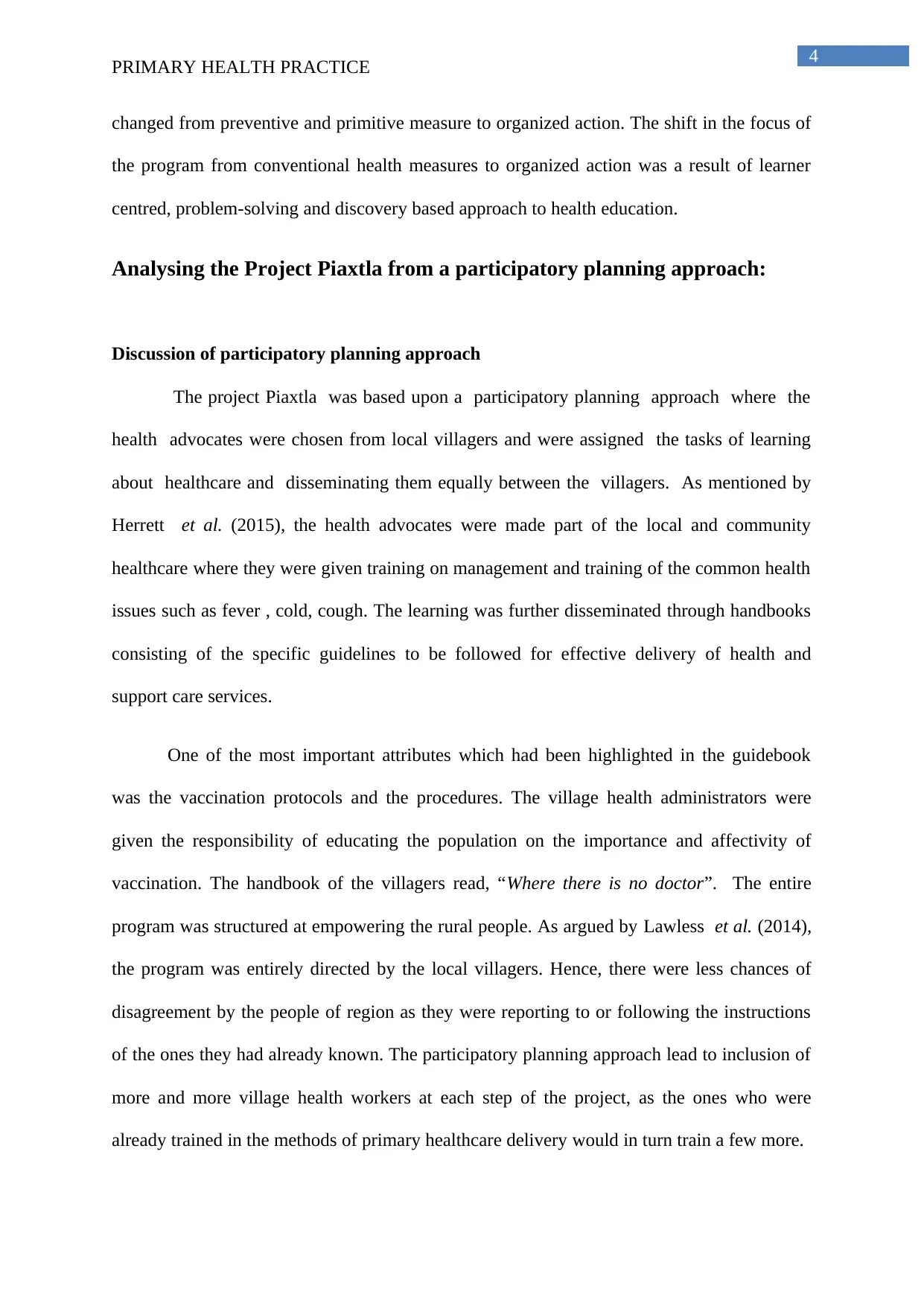
4
PRIMARY HEALTH PRACTICE
changed from preventive and primitive measure to organized action. The shift in the focus of
the program from conventional health measures to organized action was a result of learner
centred, problem-solving and discovery based approach to health education.
Analysing the Project Piaxtla from a participatory planning approach:
Discussion of participatory planning approach
The project Piaxtla was based upon a participatory planning approach where the
health advocates were chosen from local villagers and were assigned the tasks of learning
about healthcare and disseminating them equally between the villagers. As mentioned by
Herrett et al. (2015), the health advocates were made part of the local and community
healthcare where they were given training on management and training of the common health
issues such as fever , cold, cough. The learning was further disseminated through handbooks
consisting of the specific guidelines to be followed for effective delivery of health and
support care services.
One of the most important attributes which had been highlighted in the guidebook
was the vaccination protocols and the procedures. The village health administrators were
given the responsibility of educating the population on the importance and affectivity of
vaccination. The handbook of the villagers read, “Where there is no doctor”. The entire
program was structured at empowering the rural people. As argued by Lawless et al. (2014),
the program was entirely directed by the local villagers. Hence, there were less chances of
disagreement by the people of region as they were reporting to or following the instructions
of the ones they had already known. The participatory planning approach lead to inclusion of
more and more village health workers at each step of the project, as the ones who were
already trained in the methods of primary healthcare delivery would in turn train a few more.
PRIMARY HEALTH PRACTICE
changed from preventive and primitive measure to organized action. The shift in the focus of
the program from conventional health measures to organized action was a result of learner
centred, problem-solving and discovery based approach to health education.
Analysing the Project Piaxtla from a participatory planning approach:
Discussion of participatory planning approach
The project Piaxtla was based upon a participatory planning approach where the
health advocates were chosen from local villagers and were assigned the tasks of learning
about healthcare and disseminating them equally between the villagers. As mentioned by
Herrett et al. (2015), the health advocates were made part of the local and community
healthcare where they were given training on management and training of the common health
issues such as fever , cold, cough. The learning was further disseminated through handbooks
consisting of the specific guidelines to be followed for effective delivery of health and
support care services.
One of the most important attributes which had been highlighted in the guidebook
was the vaccination protocols and the procedures. The village health administrators were
given the responsibility of educating the population on the importance and affectivity of
vaccination. The handbook of the villagers read, “Where there is no doctor”. The entire
program was structured at empowering the rural people. As argued by Lawless et al. (2014),
the program was entirely directed by the local villagers. Hence, there were less chances of
disagreement by the people of region as they were reporting to or following the instructions
of the ones they had already known. The participatory planning approach lead to inclusion of
more and more village health workers at each step of the project, as the ones who were
already trained in the methods of primary healthcare delivery would in turn train a few more.
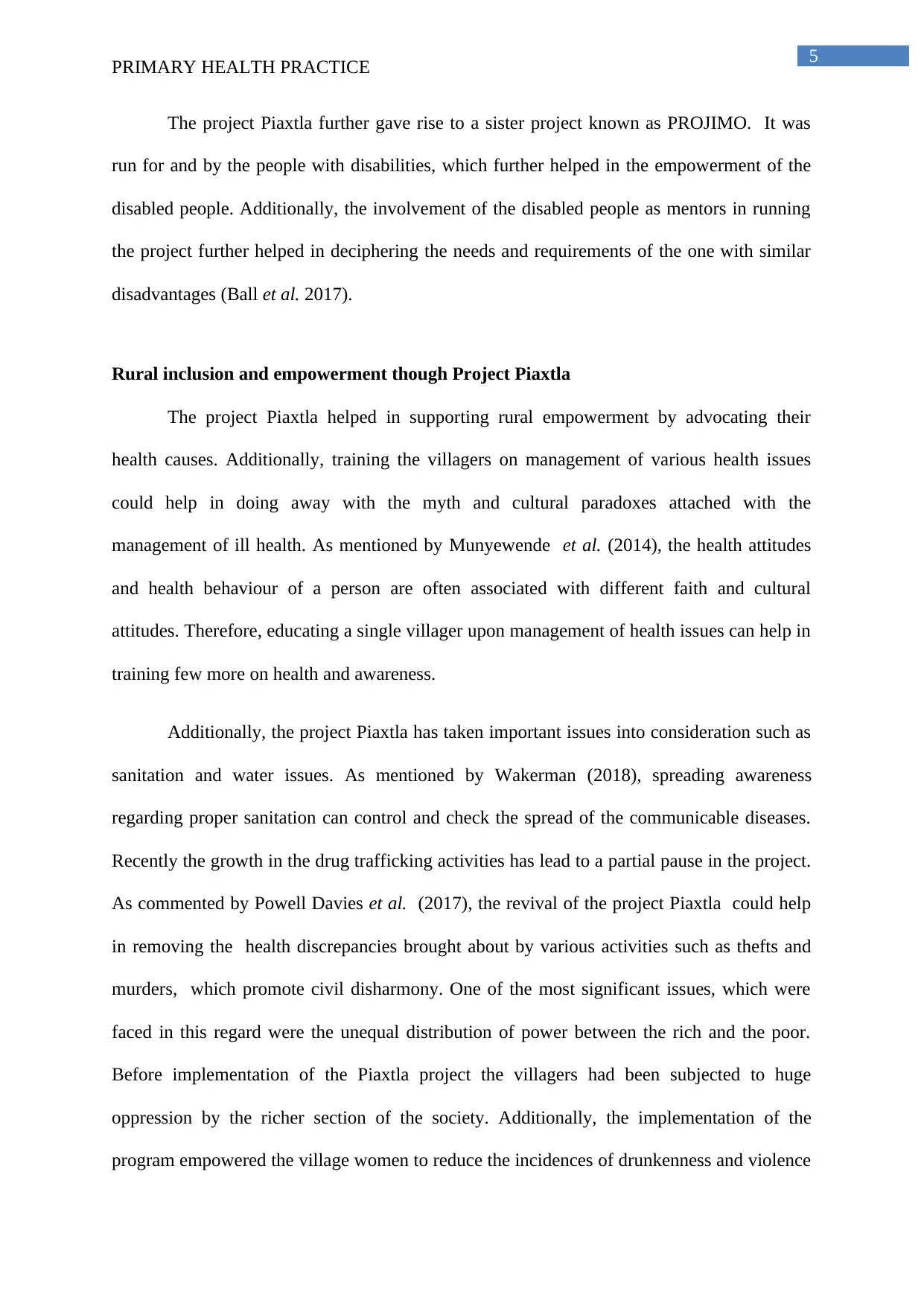
5
PRIMARY HEALTH PRACTICE
The project Piaxtla further gave rise to a sister project known as PROJIMO. It was
run for and by the people with disabilities, which further helped in the empowerment of the
disabled people. Additionally, the involvement of the disabled people as mentors in running
the project further helped in deciphering the needs and requirements of the one with similar
disadvantages (Ball et al. 2017).
Rural inclusion and empowerment though Project Piaxtla
The project Piaxtla helped in supporting rural empowerment by advocating their
health causes. Additionally, training the villagers on management of various health issues
could help in doing away with the myth and cultural paradoxes attached with the
management of ill health. As mentioned by Munyewende et al. (2014), the health attitudes
and health behaviour of a person are often associated with different faith and cultural
attitudes. Therefore, educating a single villager upon management of health issues can help in
training few more on health and awareness.
Additionally, the project Piaxtla has taken important issues into consideration such as
sanitation and water issues. As mentioned by Wakerman (2018), spreading awareness
regarding proper sanitation can control and check the spread of the communicable diseases.
Recently the growth in the drug trafficking activities has lead to a partial pause in the project.
As commented by Powell Davies et al. (2017), the revival of the project Piaxtla could help
in removing the health discrepancies brought about by various activities such as thefts and
murders, which promote civil disharmony. One of the most significant issues, which were
faced in this regard were the unequal distribution of power between the rich and the poor.
Before implementation of the Piaxtla project the villagers had been subjected to huge
oppression by the richer section of the society. Additionally, the implementation of the
program empowered the village women to reduce the incidences of drunkenness and violence
PRIMARY HEALTH PRACTICE
The project Piaxtla further gave rise to a sister project known as PROJIMO. It was
run for and by the people with disabilities, which further helped in the empowerment of the
disabled people. Additionally, the involvement of the disabled people as mentors in running
the project further helped in deciphering the needs and requirements of the one with similar
disadvantages (Ball et al. 2017).
Rural inclusion and empowerment though Project Piaxtla
The project Piaxtla helped in supporting rural empowerment by advocating their
health causes. Additionally, training the villagers on management of various health issues
could help in doing away with the myth and cultural paradoxes attached with the
management of ill health. As mentioned by Munyewende et al. (2014), the health attitudes
and health behaviour of a person are often associated with different faith and cultural
attitudes. Therefore, educating a single villager upon management of health issues can help in
training few more on health and awareness.
Additionally, the project Piaxtla has taken important issues into consideration such as
sanitation and water issues. As mentioned by Wakerman (2018), spreading awareness
regarding proper sanitation can control and check the spread of the communicable diseases.
Recently the growth in the drug trafficking activities has lead to a partial pause in the project.
As commented by Powell Davies et al. (2017), the revival of the project Piaxtla could help
in removing the health discrepancies brought about by various activities such as thefts and
murders, which promote civil disharmony. One of the most significant issues, which were
faced in this regard were the unequal distribution of power between the rich and the poor.
Before implementation of the Piaxtla project the villagers had been subjected to huge
oppression by the richer section of the society. Additionally, the implementation of the
program empowered the village women to reduce the incidences of drunkenness and violence

6
PRIMARY HEALTH PRACTICE
by closing the local beer shops. They were supported by the local community healthcare
leaders which guaranteed further success of the program. Through the project the control of
the village water systems from the local wealthy men were taken and a public water system
was introduced which was aimed towards making the community stronger. One of the most
significant initiatives in this regard was the cooperative maize bank. Under this, the farmers
and the local health workers managed to get a part of the river bottom land. The cooperative
corn bank provided the local villagers with corn at very low interest compared to the huge
300% interest charged by the land owners (Edington, 2017).
Critical analysis of the project
The project Piaxtla helped the local villagers overcome poverty and poor health. The
project helped cope up with the drastic figures such as 34% of the children died in the first
five years of their life owing to common health issues such as diarrhoea, whooping cough,
measles, etc (Fernández Velázquez 2016). It was found that under the corrupt land authorities
that the rich kept on increasing their share of land. As mentioned by Craig et al. (2016), the
implementation of the project made people more aware of the curative self care. Additionally,
taking the project on serious basis made people realize that some of the illnesses occurred in a
repetitive manner. The program helped in shifting towards more preventive measures such
as providing the children with vaccination programs , focussing more upon sanitation and
water systems. Some of this measure was effective in improving the overall health condition
of the women and the children in that region. It was seen that the women often suffered
sexual health issues s owing to improper sanitation. However as argued by Scrinis et al.
(2014), the success of the measures implemented were dependent upon the success of the
harvests. It was found that the preventive measures were really low on implementation the
PRIMARY HEALTH PRACTICE
by closing the local beer shops. They were supported by the local community healthcare
leaders which guaranteed further success of the program. Through the project the control of
the village water systems from the local wealthy men were taken and a public water system
was introduced which was aimed towards making the community stronger. One of the most
significant initiatives in this regard was the cooperative maize bank. Under this, the farmers
and the local health workers managed to get a part of the river bottom land. The cooperative
corn bank provided the local villagers with corn at very low interest compared to the huge
300% interest charged by the land owners (Edington, 2017).
Critical analysis of the project
The project Piaxtla helped the local villagers overcome poverty and poor health. The
project helped cope up with the drastic figures such as 34% of the children died in the first
five years of their life owing to common health issues such as diarrhoea, whooping cough,
measles, etc (Fernández Velázquez 2016). It was found that under the corrupt land authorities
that the rich kept on increasing their share of land. As mentioned by Craig et al. (2016), the
implementation of the project made people more aware of the curative self care. Additionally,
taking the project on serious basis made people realize that some of the illnesses occurred in a
repetitive manner. The program helped in shifting towards more preventive measures such
as providing the children with vaccination programs , focussing more upon sanitation and
water systems. Some of this measure was effective in improving the overall health condition
of the women and the children in that region. It was seen that the women often suffered
sexual health issues s owing to improper sanitation. However as argued by Scrinis et al.
(2014), the success of the measures implemented were dependent upon the success of the
harvests. It was found that the preventive measures were really low on implementation the
Paraphrase This Document
Need a fresh take? Get an instant paraphrase of this document with our AI Paraphraser
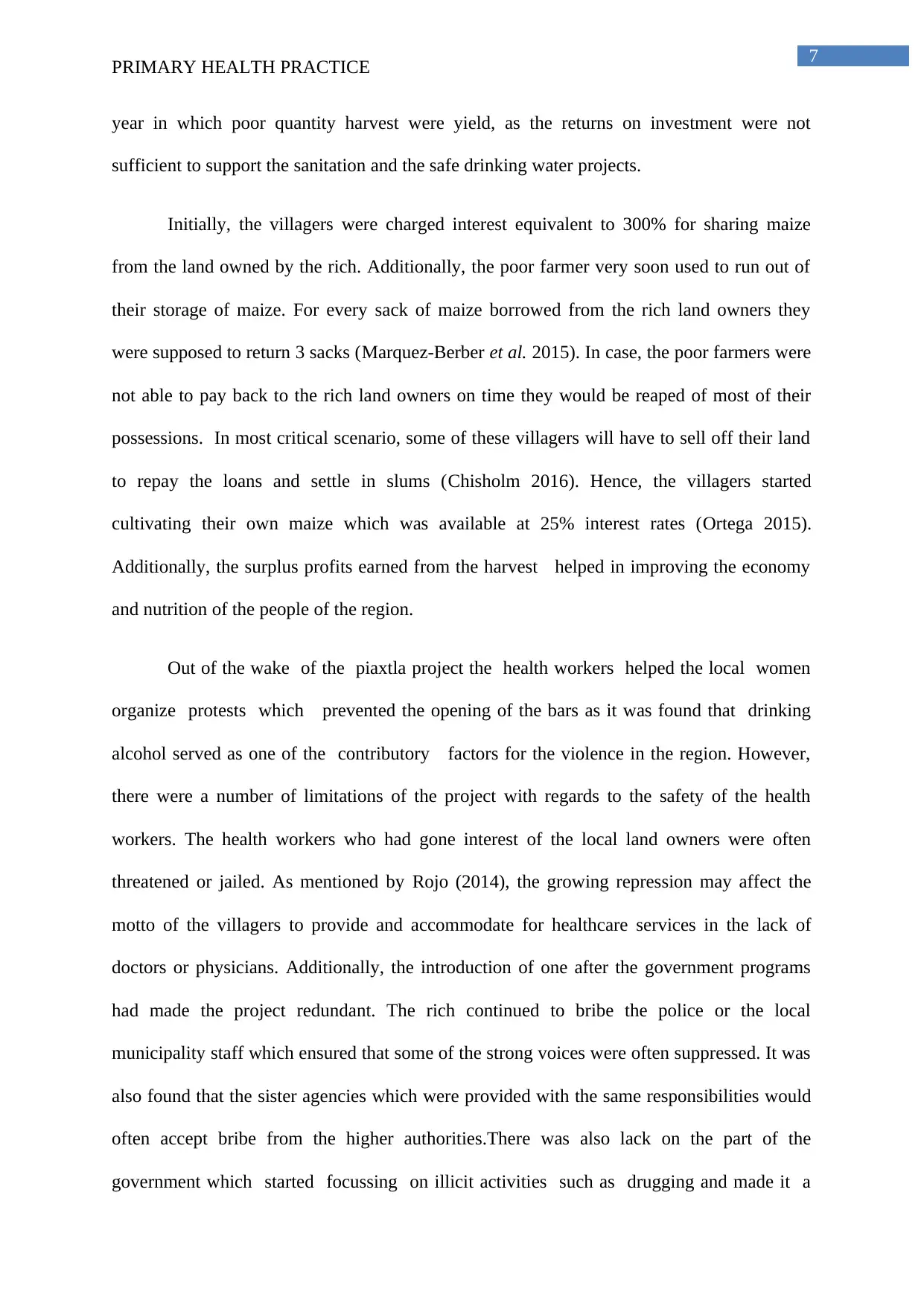
7
PRIMARY HEALTH PRACTICE
year in which poor quantity harvest were yield, as the returns on investment were not
sufficient to support the sanitation and the safe drinking water projects.
Initially, the villagers were charged interest equivalent to 300% for sharing maize
from the land owned by the rich. Additionally, the poor farmer very soon used to run out of
their storage of maize. For every sack of maize borrowed from the rich land owners they
were supposed to return 3 sacks (Marquez-Berber et al. 2015). In case, the poor farmers were
not able to pay back to the rich land owners on time they would be reaped of most of their
possessions. In most critical scenario, some of these villagers will have to sell off their land
to repay the loans and settle in slums (Chisholm 2016). Hence, the villagers started
cultivating their own maize which was available at 25% interest rates (Ortega 2015).
Additionally, the surplus profits earned from the harvest helped in improving the economy
and nutrition of the people of the region.
Out of the wake of the piaxtla project the health workers helped the local women
organize protests which prevented the opening of the bars as it was found that drinking
alcohol served as one of the contributory factors for the violence in the region. However,
there were a number of limitations of the project with regards to the safety of the health
workers. The health workers who had gone interest of the local land owners were often
threatened or jailed. As mentioned by Rojo (2014), the growing repression may affect the
motto of the villagers to provide and accommodate for healthcare services in the lack of
doctors or physicians. Additionally, the introduction of one after the government programs
had made the project redundant. The rich continued to bribe the police or the local
municipality staff which ensured that some of the strong voices were often suppressed. It was
also found that the sister agencies which were provided with the same responsibilities would
often accept bribe from the higher authorities.There was also lack on the part of the
government which started focussing on illicit activities such as drugging and made it a
PRIMARY HEALTH PRACTICE
year in which poor quantity harvest were yield, as the returns on investment were not
sufficient to support the sanitation and the safe drinking water projects.
Initially, the villagers were charged interest equivalent to 300% for sharing maize
from the land owned by the rich. Additionally, the poor farmer very soon used to run out of
their storage of maize. For every sack of maize borrowed from the rich land owners they
were supposed to return 3 sacks (Marquez-Berber et al. 2015). In case, the poor farmers were
not able to pay back to the rich land owners on time they would be reaped of most of their
possessions. In most critical scenario, some of these villagers will have to sell off their land
to repay the loans and settle in slums (Chisholm 2016). Hence, the villagers started
cultivating their own maize which was available at 25% interest rates (Ortega 2015).
Additionally, the surplus profits earned from the harvest helped in improving the economy
and nutrition of the people of the region.
Out of the wake of the piaxtla project the health workers helped the local women
organize protests which prevented the opening of the bars as it was found that drinking
alcohol served as one of the contributory factors for the violence in the region. However,
there were a number of limitations of the project with regards to the safety of the health
workers. The health workers who had gone interest of the local land owners were often
threatened or jailed. As mentioned by Rojo (2014), the growing repression may affect the
motto of the villagers to provide and accommodate for healthcare services in the lack of
doctors or physicians. Additionally, the introduction of one after the government programs
had made the project redundant. The rich continued to bribe the police or the local
municipality staff which ensured that some of the strong voices were often suppressed. It was
also found that the sister agencies which were provided with the same responsibilities would
often accept bribe from the higher authorities.There was also lack on the part of the
government which started focussing on illicit activities such as drugging and made it a
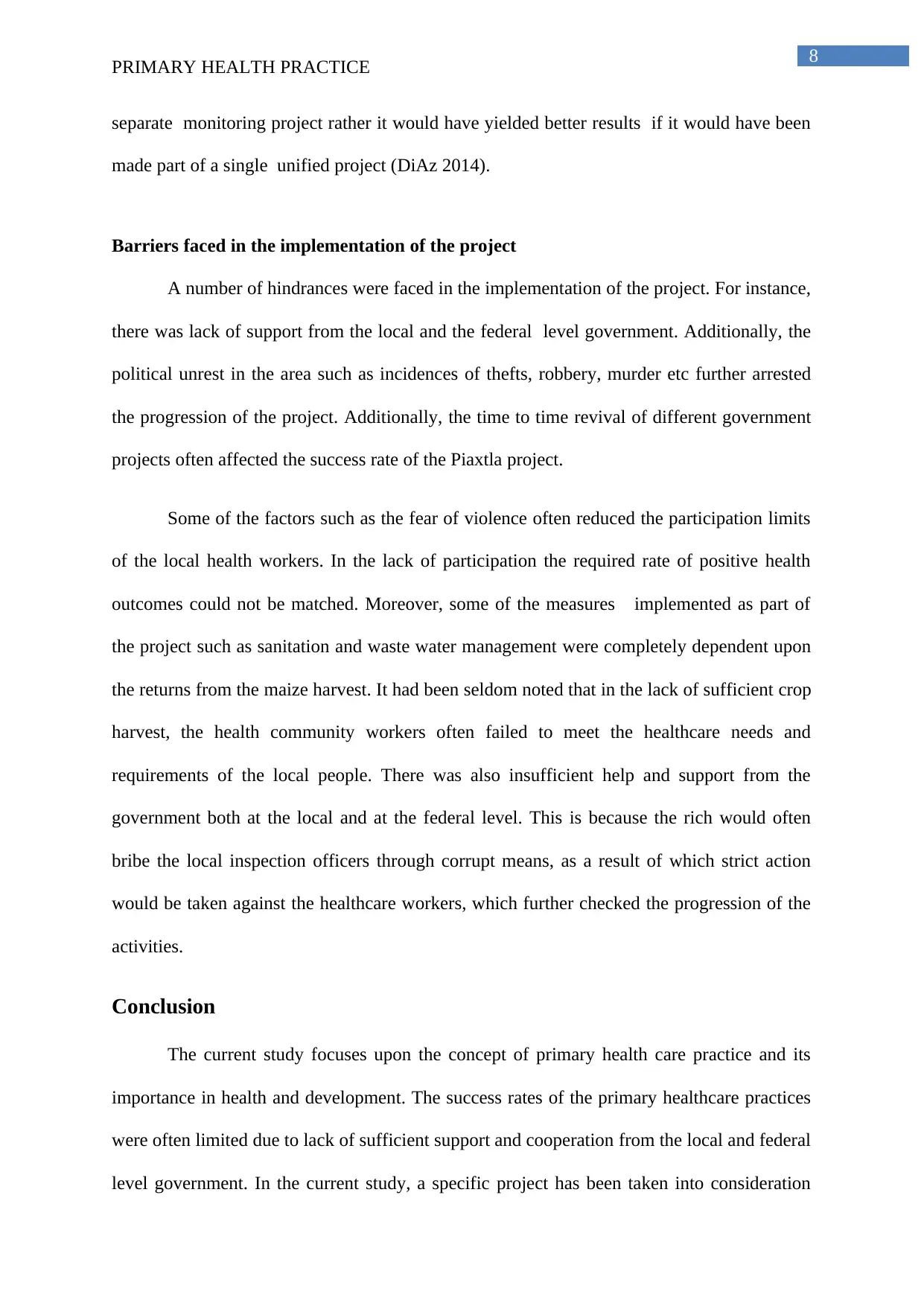
8
PRIMARY HEALTH PRACTICE
separate monitoring project rather it would have yielded better results if it would have been
made part of a single unified project (DiAz 2014).
Barriers faced in the implementation of the project
A number of hindrances were faced in the implementation of the project. For instance,
there was lack of support from the local and the federal level government. Additionally, the
political unrest in the area such as incidences of thefts, robbery, murder etc further arrested
the progression of the project. Additionally, the time to time revival of different government
projects often affected the success rate of the Piaxtla project.
Some of the factors such as the fear of violence often reduced the participation limits
of the local health workers. In the lack of participation the required rate of positive health
outcomes could not be matched. Moreover, some of the measures implemented as part of
the project such as sanitation and waste water management were completely dependent upon
the returns from the maize harvest. It had been seldom noted that in the lack of sufficient crop
harvest, the health community workers often failed to meet the healthcare needs and
requirements of the local people. There was also insufficient help and support from the
government both at the local and at the federal level. This is because the rich would often
bribe the local inspection officers through corrupt means, as a result of which strict action
would be taken against the healthcare workers, which further checked the progression of the
activities.
Conclusion
The current study focuses upon the concept of primary health care practice and its
importance in health and development. The success rates of the primary healthcare practices
were often limited due to lack of sufficient support and cooperation from the local and federal
level government. In the current study, a specific project has been taken into consideration
PRIMARY HEALTH PRACTICE
separate monitoring project rather it would have yielded better results if it would have been
made part of a single unified project (DiAz 2014).
Barriers faced in the implementation of the project
A number of hindrances were faced in the implementation of the project. For instance,
there was lack of support from the local and the federal level government. Additionally, the
political unrest in the area such as incidences of thefts, robbery, murder etc further arrested
the progression of the project. Additionally, the time to time revival of different government
projects often affected the success rate of the Piaxtla project.
Some of the factors such as the fear of violence often reduced the participation limits
of the local health workers. In the lack of participation the required rate of positive health
outcomes could not be matched. Moreover, some of the measures implemented as part of
the project such as sanitation and waste water management were completely dependent upon
the returns from the maize harvest. It had been seldom noted that in the lack of sufficient crop
harvest, the health community workers often failed to meet the healthcare needs and
requirements of the local people. There was also insufficient help and support from the
government both at the local and at the federal level. This is because the rich would often
bribe the local inspection officers through corrupt means, as a result of which strict action
would be taken against the healthcare workers, which further checked the progression of the
activities.
Conclusion
The current study focuses upon the concept of primary health care practice and its
importance in health and development. The success rates of the primary healthcare practices
were often limited due to lack of sufficient support and cooperation from the local and federal
level government. In the current study, a specific project has been taken into consideration
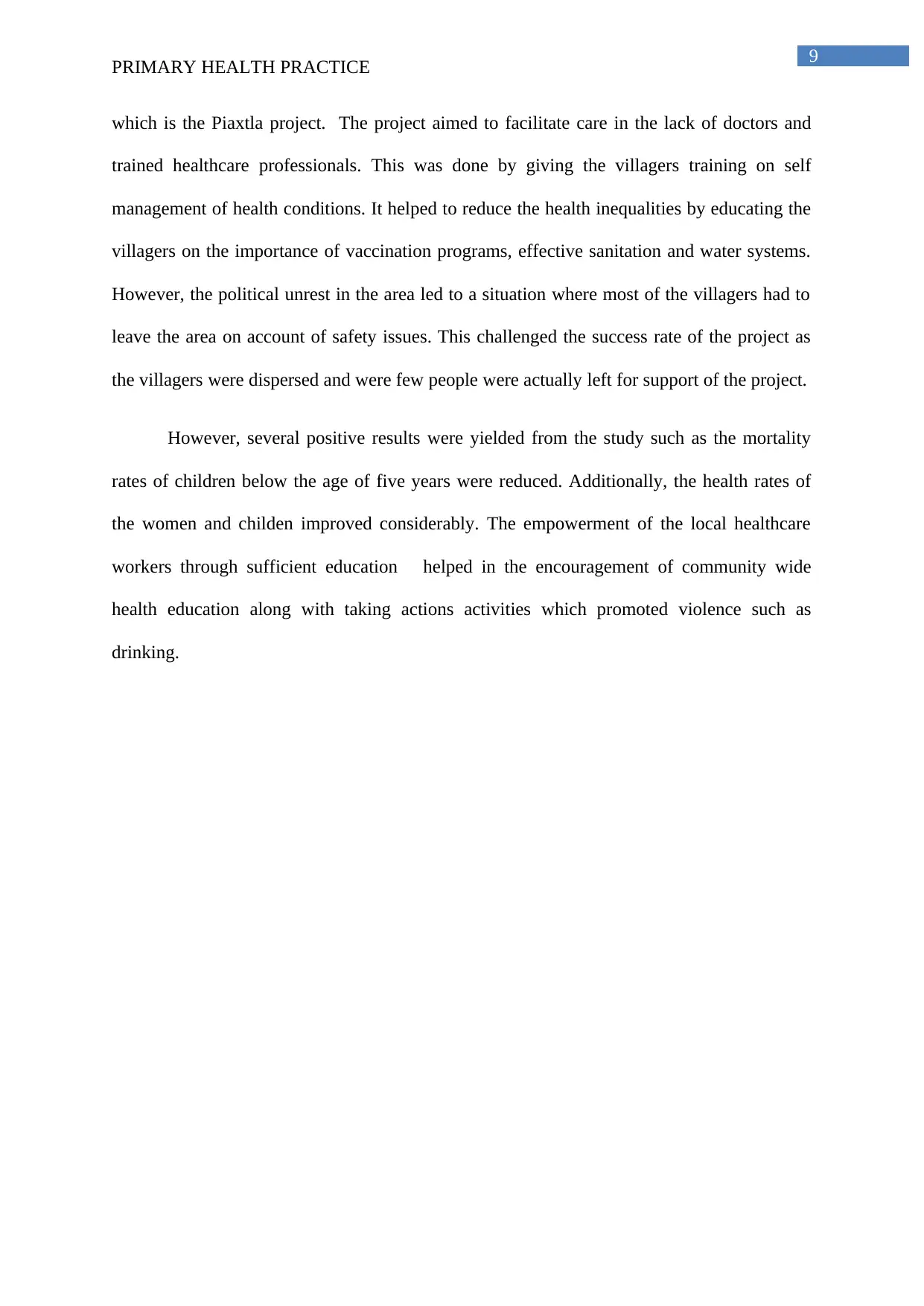
9
PRIMARY HEALTH PRACTICE
which is the Piaxtla project. The project aimed to facilitate care in the lack of doctors and
trained healthcare professionals. This was done by giving the villagers training on self
management of health conditions. It helped to reduce the health inequalities by educating the
villagers on the importance of vaccination programs, effective sanitation and water systems.
However, the political unrest in the area led to a situation where most of the villagers had to
leave the area on account of safety issues. This challenged the success rate of the project as
the villagers were dispersed and were few people were actually left for support of the project.
However, several positive results were yielded from the study such as the mortality
rates of children below the age of five years were reduced. Additionally, the health rates of
the women and childen improved considerably. The empowerment of the local healthcare
workers through sufficient education helped in the encouragement of community wide
health education along with taking actions activities which promoted violence such as
drinking.
PRIMARY HEALTH PRACTICE
which is the Piaxtla project. The project aimed to facilitate care in the lack of doctors and
trained healthcare professionals. This was done by giving the villagers training on self
management of health conditions. It helped to reduce the health inequalities by educating the
villagers on the importance of vaccination programs, effective sanitation and water systems.
However, the political unrest in the area led to a situation where most of the villagers had to
leave the area on account of safety issues. This challenged the success rate of the project as
the villagers were dispersed and were few people were actually left for support of the project.
However, several positive results were yielded from the study such as the mortality
rates of children below the age of five years were reduced. Additionally, the health rates of
the women and childen improved considerably. The empowerment of the local healthcare
workers through sufficient education helped in the encouragement of community wide
health education along with taking actions activities which promoted violence such as
drinking.
Secure Best Marks with AI Grader
Need help grading? Try our AI Grader for instant feedback on your assignments.
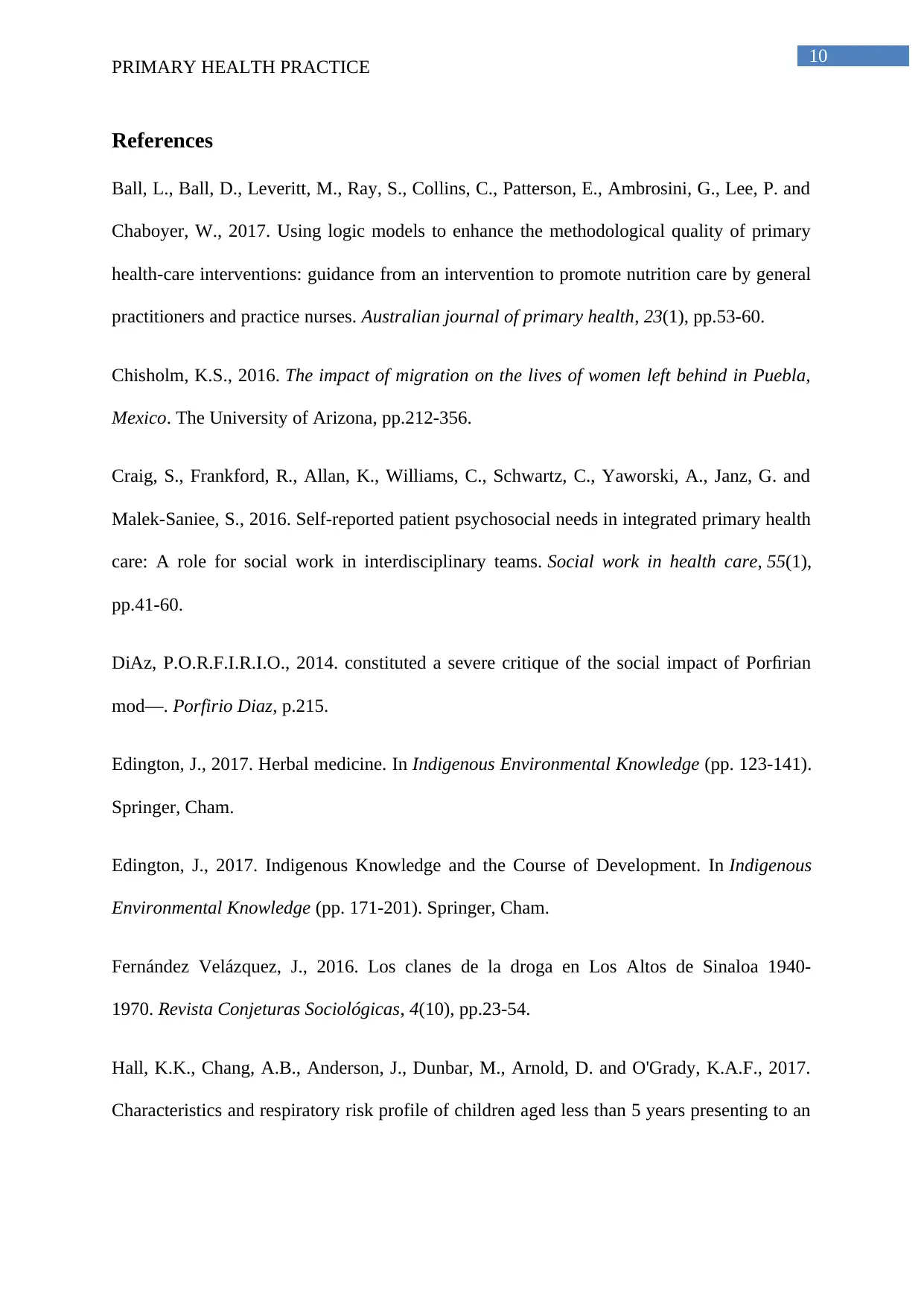
10
PRIMARY HEALTH PRACTICE
References
Ball, L., Ball, D., Leveritt, M., Ray, S., Collins, C., Patterson, E., Ambrosini, G., Lee, P. and
Chaboyer, W., 2017. Using logic models to enhance the methodological quality of primary
health-care interventions: guidance from an intervention to promote nutrition care by general
practitioners and practice nurses. Australian journal of primary health, 23(1), pp.53-60.
Chisholm, K.S., 2016. The impact of migration on the lives of women left behind in Puebla,
Mexico. The University of Arizona, pp.212-356.
Craig, S., Frankford, R., Allan, K., Williams, C., Schwartz, C., Yaworski, A., Janz, G. and
Malek-Saniee, S., 2016. Self-reported patient psychosocial needs in integrated primary health
care: A role for social work in interdisciplinary teams. Social work in health care, 55(1),
pp.41-60.
DiAz, P.O.R.F.I.R.I.O., 2014. constituted a severe critique of the social impact of Porfirian
mod—. Porfirio Diaz, p.215.
Edington, J., 2017. Herbal medicine. In Indigenous Environmental Knowledge (pp. 123-141).
Springer, Cham.
Edington, J., 2017. Indigenous Knowledge and the Course of Development. In Indigenous
Environmental Knowledge (pp. 171-201). Springer, Cham.
Fernández Velázquez, J., 2016. Los clanes de la droga en Los Altos de Sinaloa 1940-
1970. Revista Conjeturas Sociológicas, 4(10), pp.23-54.
Hall, K.K., Chang, A.B., Anderson, J., Dunbar, M., Arnold, D. and O'Grady, K.A.F., 2017.
Characteristics and respiratory risk profile of children aged less than 5 years presenting to an
PRIMARY HEALTH PRACTICE
References
Ball, L., Ball, D., Leveritt, M., Ray, S., Collins, C., Patterson, E., Ambrosini, G., Lee, P. and
Chaboyer, W., 2017. Using logic models to enhance the methodological quality of primary
health-care interventions: guidance from an intervention to promote nutrition care by general
practitioners and practice nurses. Australian journal of primary health, 23(1), pp.53-60.
Chisholm, K.S., 2016. The impact of migration on the lives of women left behind in Puebla,
Mexico. The University of Arizona, pp.212-356.
Craig, S., Frankford, R., Allan, K., Williams, C., Schwartz, C., Yaworski, A., Janz, G. and
Malek-Saniee, S., 2016. Self-reported patient psychosocial needs in integrated primary health
care: A role for social work in interdisciplinary teams. Social work in health care, 55(1),
pp.41-60.
DiAz, P.O.R.F.I.R.I.O., 2014. constituted a severe critique of the social impact of Porfirian
mod—. Porfirio Diaz, p.215.
Edington, J., 2017. Herbal medicine. In Indigenous Environmental Knowledge (pp. 123-141).
Springer, Cham.
Edington, J., 2017. Indigenous Knowledge and the Course of Development. In Indigenous
Environmental Knowledge (pp. 171-201). Springer, Cham.
Fernández Velázquez, J., 2016. Los clanes de la droga en Los Altos de Sinaloa 1940-
1970. Revista Conjeturas Sociológicas, 4(10), pp.23-54.
Hall, K.K., Chang, A.B., Anderson, J., Dunbar, M., Arnold, D. and O'Grady, K.A.F., 2017.
Characteristics and respiratory risk profile of children aged less than 5 years presenting to an
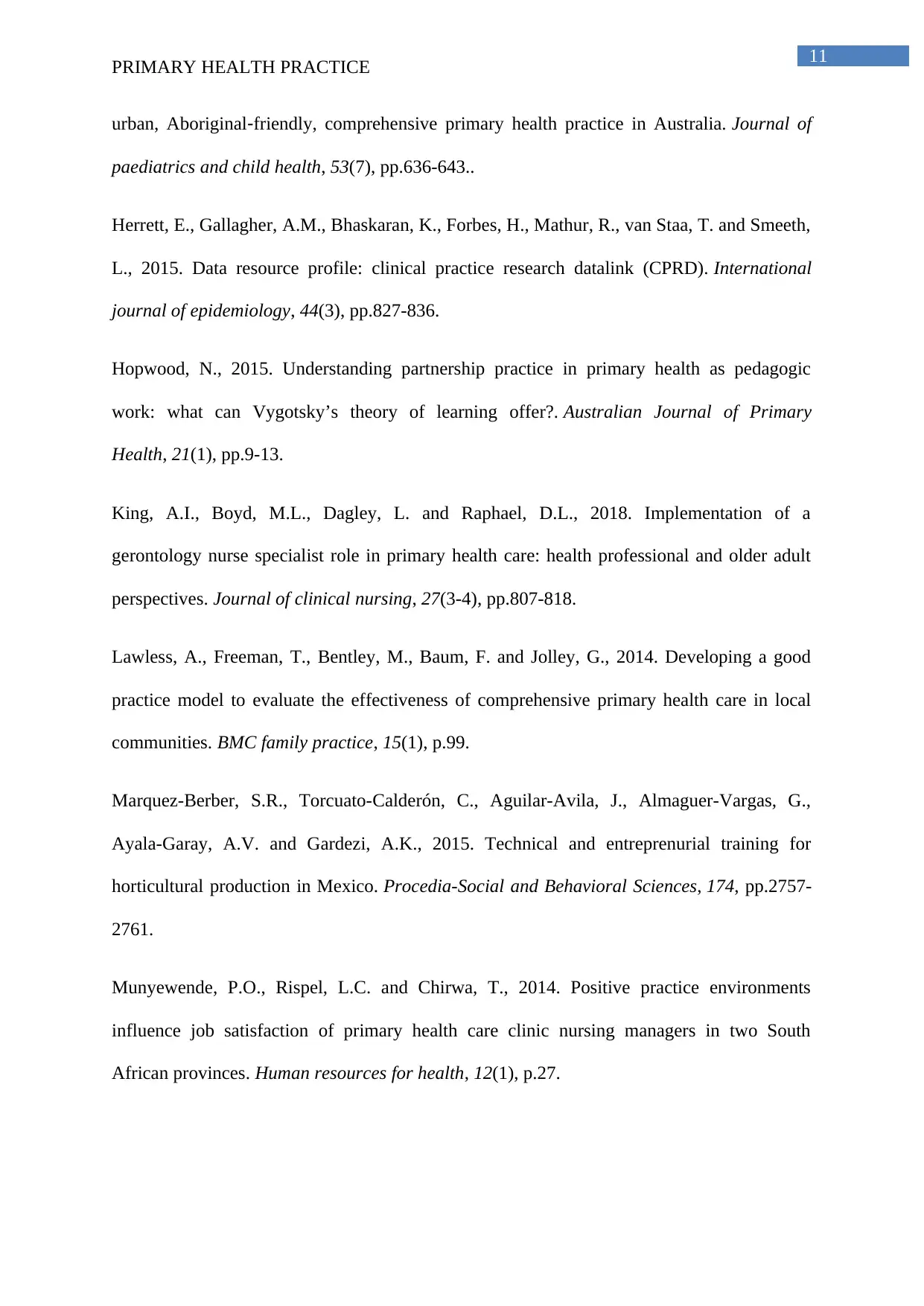
11
PRIMARY HEALTH PRACTICE
urban, Aboriginal‐friendly, comprehensive primary health practice in Australia. Journal of
paediatrics and child health, 53(7), pp.636-643..
Herrett, E., Gallagher, A.M., Bhaskaran, K., Forbes, H., Mathur, R., van Staa, T. and Smeeth,
L., 2015. Data resource profile: clinical practice research datalink (CPRD). International
journal of epidemiology, 44(3), pp.827-836.
Hopwood, N., 2015. Understanding partnership practice in primary health as pedagogic
work: what can Vygotsky’s theory of learning offer?. Australian Journal of Primary
Health, 21(1), pp.9-13.
King, A.I., Boyd, M.L., Dagley, L. and Raphael, D.L., 2018. Implementation of a
gerontology nurse specialist role in primary health care: health professional and older adult
perspectives. Journal of clinical nursing, 27(3-4), pp.807-818.
Lawless, A., Freeman, T., Bentley, M., Baum, F. and Jolley, G., 2014. Developing a good
practice model to evaluate the effectiveness of comprehensive primary health care in local
communities. BMC family practice, 15(1), p.99.
Marquez-Berber, S.R., Torcuato-Calderón, C., Aguilar-Avila, J., Almaguer-Vargas, G.,
Ayala-Garay, A.V. and Gardezi, A.K., 2015. Technical and entreprenurial training for
horticultural production in Mexico. Procedia-Social and Behavioral Sciences, 174, pp.2757-
2761.
Munyewende, P.O., Rispel, L.C. and Chirwa, T., 2014. Positive practice environments
influence job satisfaction of primary health care clinic nursing managers in two South
African provinces. Human resources for health, 12(1), p.27.
PRIMARY HEALTH PRACTICE
urban, Aboriginal‐friendly, comprehensive primary health practice in Australia. Journal of
paediatrics and child health, 53(7), pp.636-643..
Herrett, E., Gallagher, A.M., Bhaskaran, K., Forbes, H., Mathur, R., van Staa, T. and Smeeth,
L., 2015. Data resource profile: clinical practice research datalink (CPRD). International
journal of epidemiology, 44(3), pp.827-836.
Hopwood, N., 2015. Understanding partnership practice in primary health as pedagogic
work: what can Vygotsky’s theory of learning offer?. Australian Journal of Primary
Health, 21(1), pp.9-13.
King, A.I., Boyd, M.L., Dagley, L. and Raphael, D.L., 2018. Implementation of a
gerontology nurse specialist role in primary health care: health professional and older adult
perspectives. Journal of clinical nursing, 27(3-4), pp.807-818.
Lawless, A., Freeman, T., Bentley, M., Baum, F. and Jolley, G., 2014. Developing a good
practice model to evaluate the effectiveness of comprehensive primary health care in local
communities. BMC family practice, 15(1), p.99.
Marquez-Berber, S.R., Torcuato-Calderón, C., Aguilar-Avila, J., Almaguer-Vargas, G.,
Ayala-Garay, A.V. and Gardezi, A.K., 2015. Technical and entreprenurial training for
horticultural production in Mexico. Procedia-Social and Behavioral Sciences, 174, pp.2757-
2761.
Munyewende, P.O., Rispel, L.C. and Chirwa, T., 2014. Positive practice environments
influence job satisfaction of primary health care clinic nursing managers in two South
African provinces. Human resources for health, 12(1), p.27.
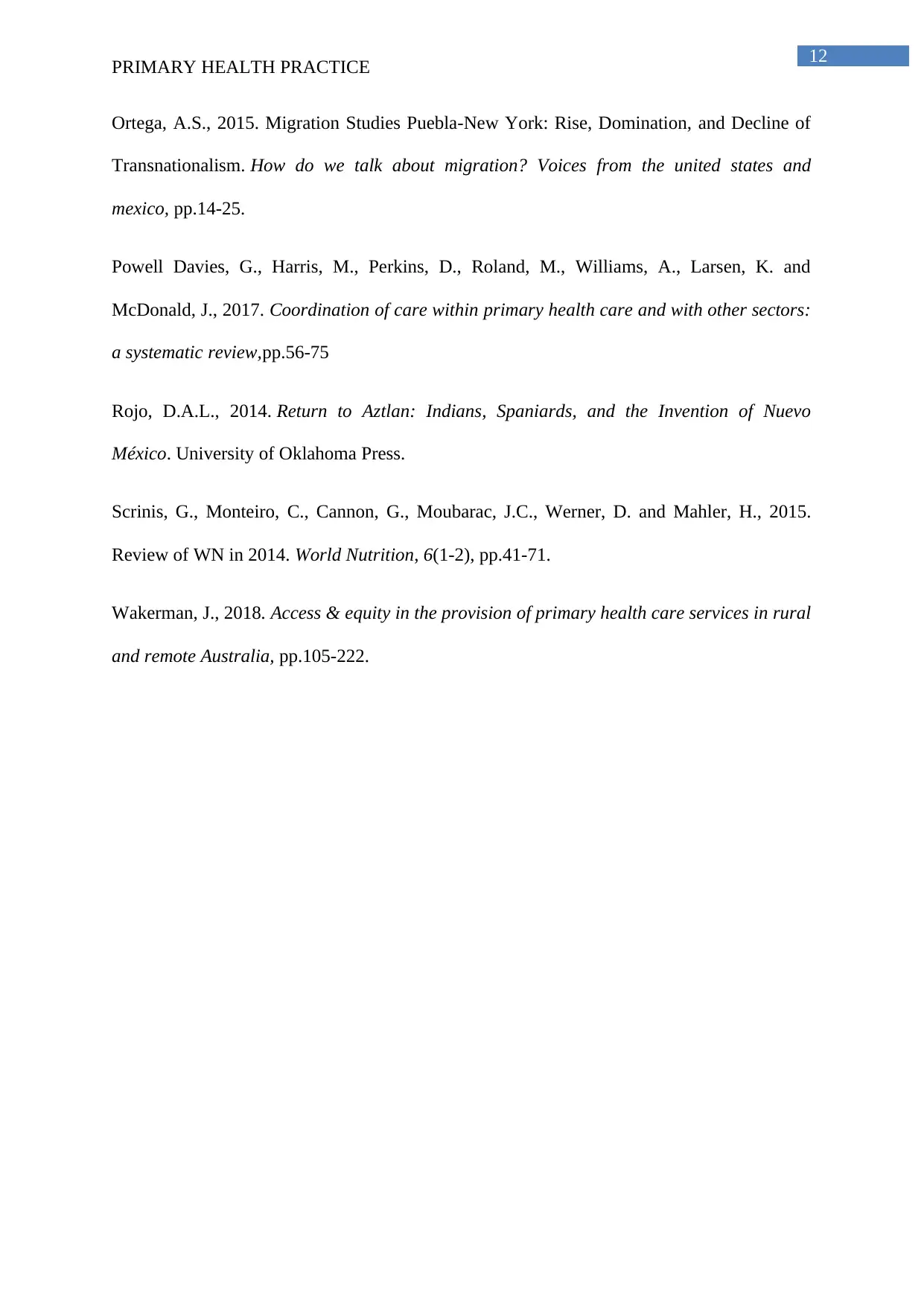
12
PRIMARY HEALTH PRACTICE
Ortega, A.S., 2015. Migration Studies Puebla-New York: Rise, Domination, and Decline of
Transnationalism. How do we talk about migration? Voices from the united states and
mexico, pp.14-25.
Powell Davies, G., Harris, M., Perkins, D., Roland, M., Williams, A., Larsen, K. and
McDonald, J., 2017. Coordination of care within primary health care and with other sectors:
a systematic review,pp.56-75
Rojo, D.A.L., 2014. Return to Aztlan: Indians, Spaniards, and the Invention of Nuevo
México. University of Oklahoma Press.
Scrinis, G., Monteiro, C., Cannon, G., Moubarac, J.C., Werner, D. and Mahler, H., 2015.
Review of WN in 2014. World Nutrition, 6(1-2), pp.41-71.
Wakerman, J., 2018. Access & equity in the provision of primary health care services in rural
and remote Australia, pp.105-222.
PRIMARY HEALTH PRACTICE
Ortega, A.S., 2015. Migration Studies Puebla-New York: Rise, Domination, and Decline of
Transnationalism. How do we talk about migration? Voices from the united states and
mexico, pp.14-25.
Powell Davies, G., Harris, M., Perkins, D., Roland, M., Williams, A., Larsen, K. and
McDonald, J., 2017. Coordination of care within primary health care and with other sectors:
a systematic review,pp.56-75
Rojo, D.A.L., 2014. Return to Aztlan: Indians, Spaniards, and the Invention of Nuevo
México. University of Oklahoma Press.
Scrinis, G., Monteiro, C., Cannon, G., Moubarac, J.C., Werner, D. and Mahler, H., 2015.
Review of WN in 2014. World Nutrition, 6(1-2), pp.41-71.
Wakerman, J., 2018. Access & equity in the provision of primary health care services in rural
and remote Australia, pp.105-222.
1 out of 13
Related Documents
Your All-in-One AI-Powered Toolkit for Academic Success.
+13062052269
info@desklib.com
Available 24*7 on WhatsApp / Email
![[object Object]](/_next/static/media/star-bottom.7253800d.svg)
Unlock your academic potential
© 2024 | Zucol Services PVT LTD | All rights reserved.





